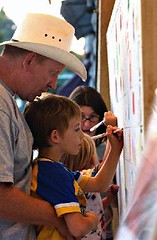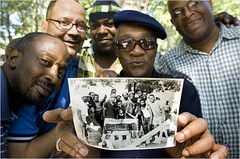Celebrating, ourselves and our communities
 Michael Pontier watches as his son, Jacob, 6, draws his piece on the kids mural, which is part of the North Adams Mural Project through the Massachusetts Museum of Contemporary Art. Photo by Caroline Bonnivier / Berkshire Eagle Staff.
Michael Pontier watches as his son, Jacob, 6, draws his piece on the kids mural, which is part of the North Adams Mural Project through the Massachusetts Museum of Contemporary Art. Photo by Caroline Bonnivier / Berkshire Eagle Staff.Many years ago I worked with Ronald Lippitt for a bit--he was one of the founders of the field of organizational development, and had a regular monthly meeting with people in his broad network. One of the things he discussed there and in his writings was the importance of celebrating and acknowledging project milestones--not waiting til the end.
I've been thinking of this kind of "acknowledgement" for a couple weeks, especially in the context of "County" and "State" fairs, which are not just about agriculture but community building.
I've run across a few articles over the past few days about this. (Maybe DC needs a "County Fair" of its own, not to mention a Downtown Celebration too...)
Today's Berkshire Eagle has a story, "Downtown party: North Adams gets down," about the North Adams Downtown Celebration, an annual night out that started in 1996 after the conclusion of a major streetscape reconstruction.
The City section of the New York Times has a piece about the annual "Old Timers Day" in the Red Hook neighborhood of Brooklyn, which brings together old and new, current and former residents. (Many people in metropolitan regions have ties to the center city, even if they left decades ago.) See "Beyond the Buzz, Red Hook Remembers."
Now, with the decline of agriculture as an industry with which people have direct experience, so too are state and county fairs facing a decrease in interest. The New York Times had a piece on this last week, "State Fairs, Sagging, Arrive at County Crossroads," focusing on the Illinois State Fair in Springfield. Many fairs are losing money with declining attendance, and are seeking state monies. From the article:
... critics say slipping attendance and increasing subsidies show that fairs have lost their role in an era in which entertainment can be found almost around every corner, defenders point to the original purposes, to teach about farming and industry, and stir a sense of community.
American fairs, whose roots can be traced at least 199 years back, to a New England farmer, Elkanah Watson, who put a small exhibition of sheep under an old elm in Pittsfield, Mass., have been a staple of rural life and a chance to promote agriculture, animal husbandry and local industry. A state fair is not a business, said Pat Haley, a state representative from Huron, S.D., home to a fair whose preview night is Aug. 30. A state fair is a social event, much like a family reunion.
Many state fairs, meanwhile, say they remain successful. Among them, said Jim D. Tucker, president and chief executive of the International Association of Fairs and Expositions, are fairs in Iowa, Minnesota, Indiana, Georgia and Washington State.
(Here are a few other interesting articles on the same topic, these two about the Indiana State Fair, which is successful, "Audience has changed, but agriculture the fair's focus," and "Innovation keeps state fair fresh for 150 years," and this summing up of this year's Illinois State Fair from the Chicago Tribune, "A blue ribbon for attendance.")
Interestingly enough, there is a preliminary report from Oregon State University extension, not just about the economic impact of county fairs, but the community building aspects. The report finds that public investment in fairs can be leveraged by more than 10 times. The report, "Oregon County Fairs: An Economic Impact Analysis," was funded by the Oregon Fairs Association and will be available in September on the OSU Rural Studies Program website.
I definitely saw the community building aspects this weekend at the Arlington County Fair, from booths for the Republicans and Democrats to alumni associations for various high schools, county agencies, award-winning vegetables, community groups, and more...
 Klaus Schoenwiese for The New York Times. "I've never felt this sense of community anywhere else," said Kenneth Berry, far right in checked shirt, one of 2,000 current and former Red Hook residents who attended Old Timers Day last week.
Klaus Schoenwiese for The New York Times. "I've never felt this sense of community anywhere else," said Kenneth Berry, far right in checked shirt, one of 2,000 current and former Red Hook residents who attended Old Timers Day last week.Index Keywords: community-building; civic-engagement



0 Comments:
Post a Comment
<< Home